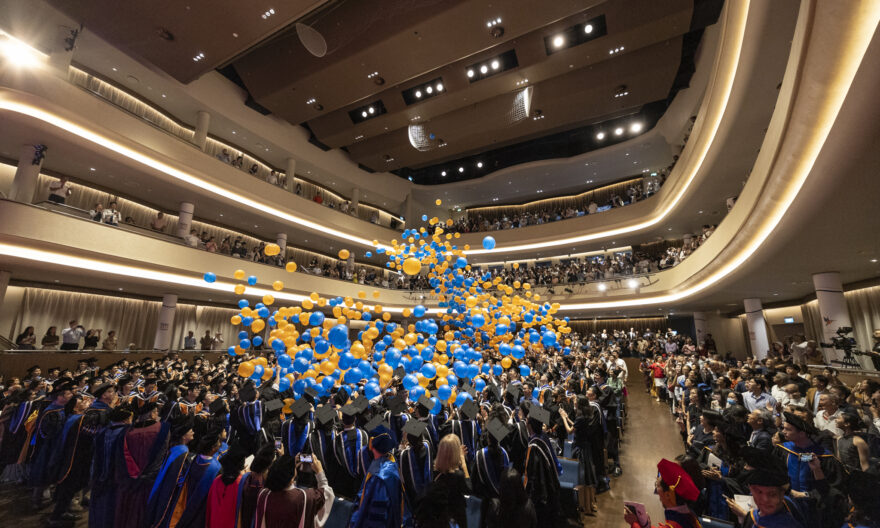Community bonding and learning about Singapore through Halcyon’s Fab Feb
First-year Yale-NUS students learn more about Singapore’s natural and cultural scenes over Recess Week
Over the Recess Week of Semester 2, the Yale-NUS Class of 2025 temporarily set their books and assignments aside in favour of participating in ‘Halcyon’s Fab Feb’, a line-up of activities organised by the Centre for International & Professional Experience (CIPE) and the Student Affairs Office (SAO). Through Fab Feb, 150 first-year students had the opportunity to explore and engage in a diverse range of activities, from kayaking on Pulau Ubin to guided night tours around Geylang.
Beth Uding, then-Associate Director of Experiential Learning at Yale-NUS College, led the planning for Fab Feb. She explained, “With Fab Feb, SAO and CIPE hope to recreate some of the fun, spontaneous experiences that the first years have missed out on due to COVID-19”. She added that Fab Feb sought to allow first-years students to “build community”, all while exploring “Singapore’s natural environment, cultural institutions, heritage, and more”.
Unathletic, but still wanting to do something with my hands, I was excited to take part in two activities: a Peranakan cooking class, and a Batik art class, both of which I found highly enjoyable and educational.
The first activity was the Peranakan cooking class, which allowed participants to try their hand at Peranakan cooking, known to be notoriously difficult. With a group of 12 other students, we went to The Providore Downtown Gallery (which has its own cooking studio), where we met with Mr Lionel Chee, who has spent more than two decades running a heritage restaurant in Singapore.
 Learning how to make Peranakan food with Mr Lionel Chee. Image provided by Chelsea Kiew.
Learning how to make Peranakan food with Mr Lionel Chee. Image provided by Chelsea Kiew.
In groups and under Mr Chee’s patient tutelage, I, along with a group of five other students, learnt how to make a variety of Peranakan dishes, including Sambal Belacan (a type of chilli paste), and Nyonya Curry. As we shakily followed Mr Chee’s instructions, my group was able to get to know each other better. We were soon happily swapping tales about the differences and similarities between Peranakan cooking, and other cuisines we might have attempted before. One of my group mates compared the process of mixing flour to make kueh (bite-size snacks) to a similar process when making macarons. Another one of us marvelled at the stark difference between the flavours and fragrance of Nyonya curry and Japanese curry, while another was surprised at the difference between spicy foods in Taiwan, and the spice of Peranakan dishes. It was fascinating listening to everyone’s past experiences with tasting and making food as we worked together.
As Mr Chee was happy to share with us, Peranakan cooking is born from the mixing and meeting of diverse culinary traditions, and as we gradually assembled our dishes, each of us also shared a bit of our own diverse experiences with food from our cultures. In the true spirit of Peranakan cooking, both international and local students were able to meet and learn more about each other through good food and stories.
On what she hoped participants will get out of Fab Feb, Associate Director Uding said, “We have always found that experiential programmes offer unique opportunities for bonding. Whether you’re walking alongside a new friend on a tour, or jumping into a kayak together, or learning side by side at a cooking class, there will be space for conversation and connection.”
Though not easy, learning how to make Peranakan dishes was an exciting challenge. Our group had a lot of fun, and despite our varying cooking abilities and experiences, we complemented each other well, and were able to make up for each other’s weaknesses or covering knowledge gaps. At the end of the class, each team also got to try the different dishes made by the different groups. Mr Chee was right – despite the same ingredients, each dish was slightly different.
The second activity I took part in was a Batik art class. Though familiar with Batik, I’ve never actually given much thought to what Batik is, or what goes into the process of creating Batik art. The workshop, taught by an artist who has been creating Batik for decades, was thus extremely eye-opening.
 The finished products: Batik art created by the Yale-NUS students. Image provided by Chelsea Kiew.
The finished products: Batik art created by the Yale-NUS students. Image provided by Chelsea Kiew.
 Participants at a Batik Art Workshop got to learn more about the process behind creating Batik Art, and even got to make their own. Image provided by Chelsea Kiew.
Participants at a Batik Art Workshop got to learn more about the process behind creating Batik Art, and even got to make their own. Image provided by Chelsea Kiew.
Being Singaporean, and having lived here my whole life. I would have assumed that I would have known a lot about things like Peranakan cuisine, or Batik art. These workshops, I am happy to share, proved me wrong, and made me realise there is still a lot of Singapore I have yet to discover. Through Halcyon’s Fab Feb, I had the opportunity to learn more about Singapore in a way that was novel and engaging. It was also really refreshing to be able to experience local culture through the eyes of my international classmates. It makes me happy knowing that despite everyone’s different experiences, we created a common memory through Fab Feb.





